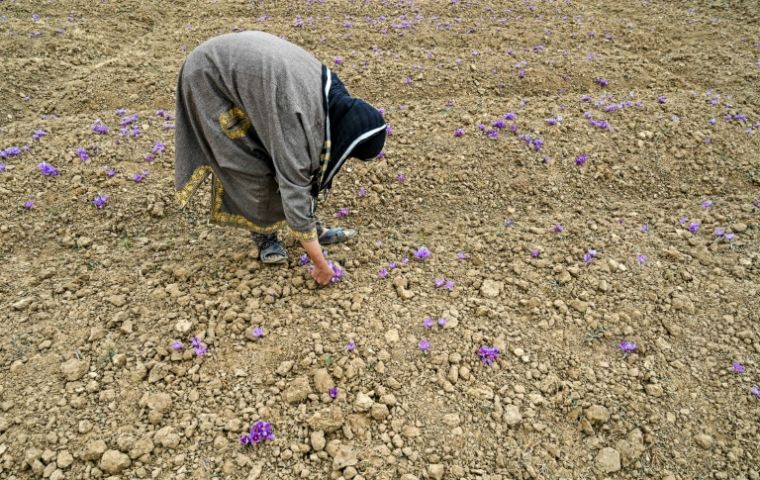MercoPress. South Atlantic News Agency
Kashmir's saffron “red gold” harvest depleted by climate change
 Dry conditions blamed on climate change have seen yields of the world’s most expensive spice halved in the past two decades
Dry conditions blamed on climate change have seen yields of the world’s most expensive spice halved in the past two decades On sweeping fields once blanketed in lush purple, a thin and bedraggled crop of flowers was all farmers in Indian-administered Kashmir’s saffron-growing region Pampore had to show for this year’s harvest.
Dry conditions blamed on climate change have seen yields of the world’s most expensive spice halved in the past two decades, threatening the future of a cash crop that has brought wealth to the region for 2,500 years.
“These fields used to be like gold mines,” said Abdul Ahad Mir in Pampore, just south of Indian-administered Kashmir’s main city, Srinagar.
Saffron has long thrived there and Mir’s family was reared in the delicate work of plucking the lucrative, but tiny crimson threads from purple crocus flowers.
“In my childhood we needed 80 men over a week to pick the flowers,” Mir told reporters. “Today our family of six finish it in a day.”
Warming temperatures caused by climate change have made rainfall erratic, depleting the thirsty saffron fields of water. Shrinking glaciers across the Himalayan region have also cut water flows to the foothills downstream.
It takes about 160,000 flowers to yield 1kg of the precious spice, which sells for about US$1,350 in local markets.
However, official figures show that harvests of the so-called “red gold” were just 1.4kg per hectare in 2018 — half the figure recorded in 1998.
Mohammad Ramzan Rather said his acreage in Pampore only produced about 30 grams of the crop this year, down from 2kg 12 years ago.
The harvest season — which lasts for just two weeks at the end of autumn — has also been devastated by the COVID-19 pandemic, as well as security lockdowns in response to a long-running insurgency in the disputed territory, claimed both by India and Pakistan.
Historians said saffron has been cultivated in Kashmir since at least 500BC.
Locally the spice is added to traditional dishes and used as an ingredient in Kehwa, a sweet drink served during special occasions such as marriages.
Elsewhere in the world, it is prized for its use in cooking and cosmetics and can fetch prices of more than US$10,000 per kilogram on the international market. Nearly 90% of the world’s saffron is grown in Iran, but experts consider Kashmir’s crop to be superior for its deep red color and distinct aroma.
In 2010, Indian authorities sought to mitigate the effects of climate change by launching a US$54 million fund to introduce modern agricultural technology to farmers. Authorities have touted it as a success, claiming it has rejuvenated Kashmir’s 1,500 hectares of saffron fields.
However, farmers disagree. They have ripped up plastic irrigation pipes that are now strewn across fields, saying they bring little water and make it harder to till the land.




Top Comments
Disclaimer & comment rulesCommenting for this story is now closed.
If you have a Facebook account, become a fan and comment on our Facebook Page!